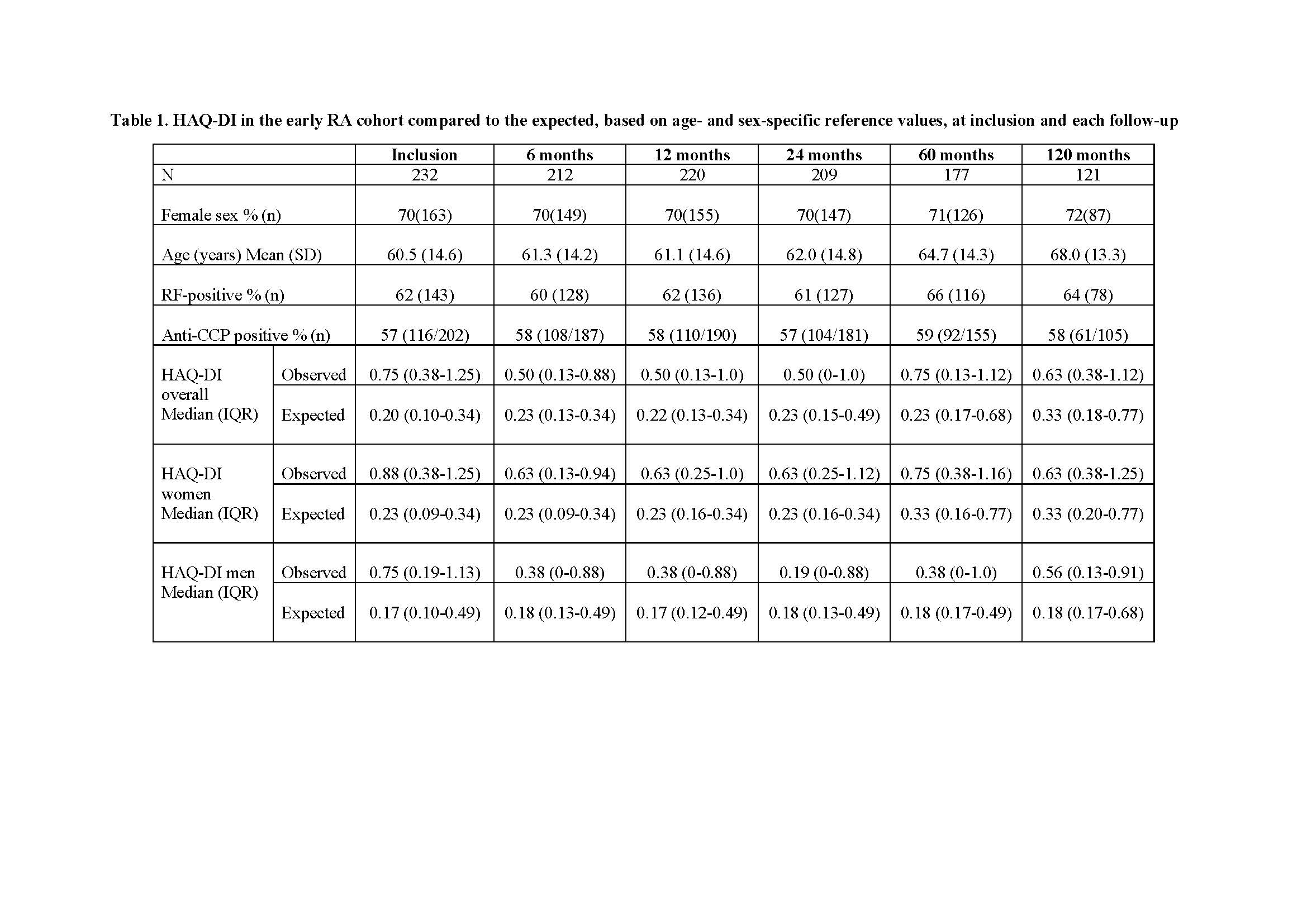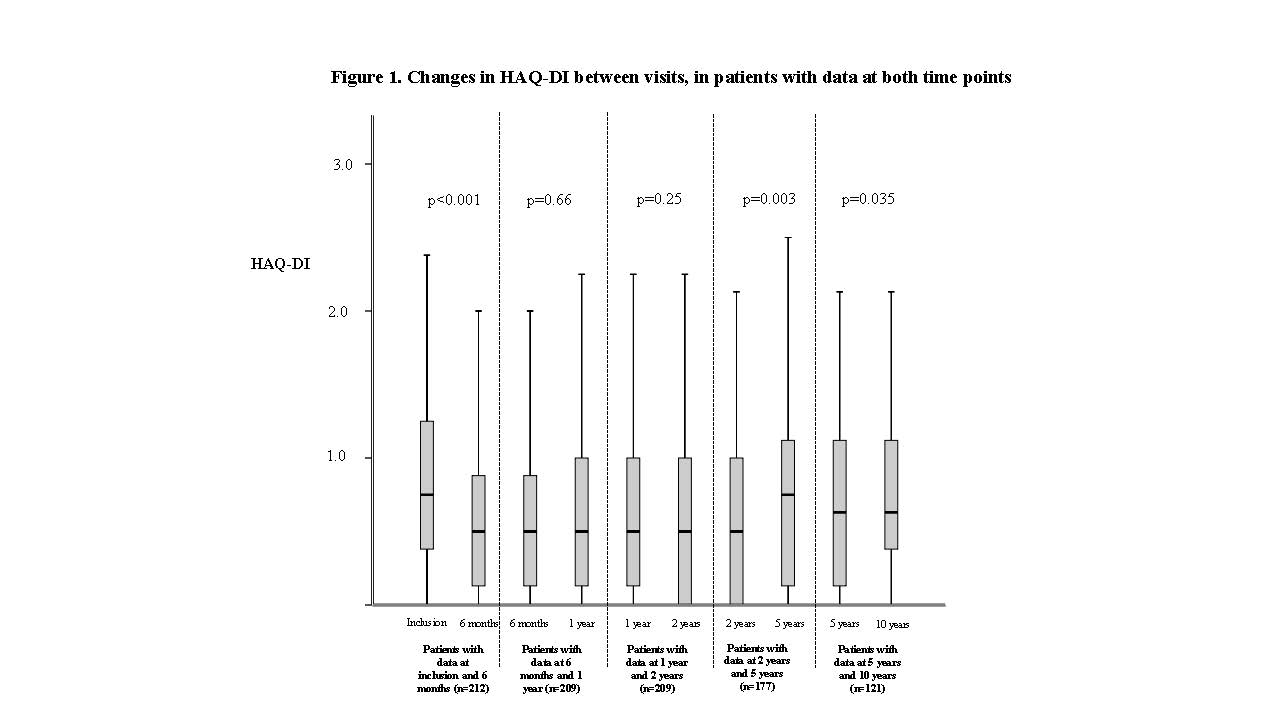Session Information
Date: Tuesday, November 12, 2019
Title: RA – Diagnosis, Manifestations, & Outcomes Poster III: Comorbidities
Session Type: Poster Session (Tuesday)
Session Time: 9:00AM-11:00AM
Background/Purpose: Patients with rheumatoid arthritis (RA) are known to have increased risk of disability. The aim of this study was to investigate the course of disability in early RA, and compare it to age- and sex specific reference values, overall and by sex.
Methods: An inception cohort of patients with early RA (symptom duration ≤12 months), recruited in Malmö 1995-2005, was followed in a structured program for 10 years. Patients were managed according to usual care, with no pre-specified protocol for pharmacotherapy or rehabilitation. Disability was assessed using the validated Swedish version of the Health Assessment Questionnaire (HAQ) and compared to expected age- and sex specific values from the literature (Krishnan et al. A&R 2004; 50: 953-60). Changes in HAQ disability index (HAQ-DI) between different time points were assessed using the paired t-test. Differences between observed and expected HAQ-DI over time after ≥6 months were investigated using linear mixed-effects models.
Results: A total of 232 patients with early RA (70 % women, mean age 60.5 years, median symptom duration 7 months) were investigated. The HAQ-DI scores for all patients are reported in Table 1 together with the corresponding expected values. In paired analysis of those with available data at both time points, there was a significant decrease in HAQ-DI from inclusion to the 6 month follow-up (Figure 1). This was followed by a stable HAQ-DI through 24 months after diagnosis. Between 24 months and 60 months, and between 60 months and 120 months, there were significant increases in HAQ-DI. (Figure 1) The median HAQ-DI was higher for women than for men at every visit, both the observed and expected values (Table 1).
In linear mixed effect models, the estimated mean difference (EMD) over time from the 6 month follow-up through 10 years between observed and expected values was 0.29 [95% confidence interval (CI) 0.26 ; 0.33] for HAQ-DI. Estimated HAQ-DI values at 6 months, based on the intercept in the model, were higher than the expected (Table 2). Observed and expected values both increased significantly after the 6 month follow-up (Table 2), with no significant difference in the change per year (EMD0.004 (95% CI -0.008; 0.016). The EMD over time between observed and expected HAQ-DI scores were greater in women (mean 0.35; 95% CI 0.31; 0.39) than in men (mean 0.15; 95% CI 0.09; 0.22). In women, observed and expected HAQ-DI values increased over time (Table 2), with a trend towards a lesser increase in observed values (EMD for change over time 0.004/year (95% CI -0.01; 0.017). In men, there was a significant increase in expected, but not in observed values (Table 2). This difference did not reach statistical significance (EMD for change over time 0.006/year (95% CI -0.015; 0.028)).
Conclusion: Disability decreased during the first 6 months after diagnosis in patients with early RA. This was followed by a stable level of disability through 2 years, and a gradual increase after 2-10 years. The change in HAQ-DI after ≥ 6 months was similar to the expected based on data from the general population, suggesting that increasing disability over time in early RA is mainly explained by increasing age.
To cite this abstract in AMA style:
Mellblom Bengtsson M, Hansson T, Rydholm M, Hagel S, Jacobsson L, Turesson C. The Course of Disability in Early Rheumatoid Arthritis over 10 Years of Follow-up in Women and Men – Comparison with the General Population [abstract]. Arthritis Rheumatol. 2019; 71 (suppl 10). https://acrabstracts.org/abstract/the-course-of-disability-in-early-rheumatoid-arthritis-over-10-years-of-follow-up-in-women-and-men-comparison-with-the-general-population/. Accessed .« Back to 2019 ACR/ARP Annual Meeting
ACR Meeting Abstracts - https://acrabstracts.org/abstract/the-course-of-disability-in-early-rheumatoid-arthritis-over-10-years-of-follow-up-in-women-and-men-comparison-with-the-general-population/



